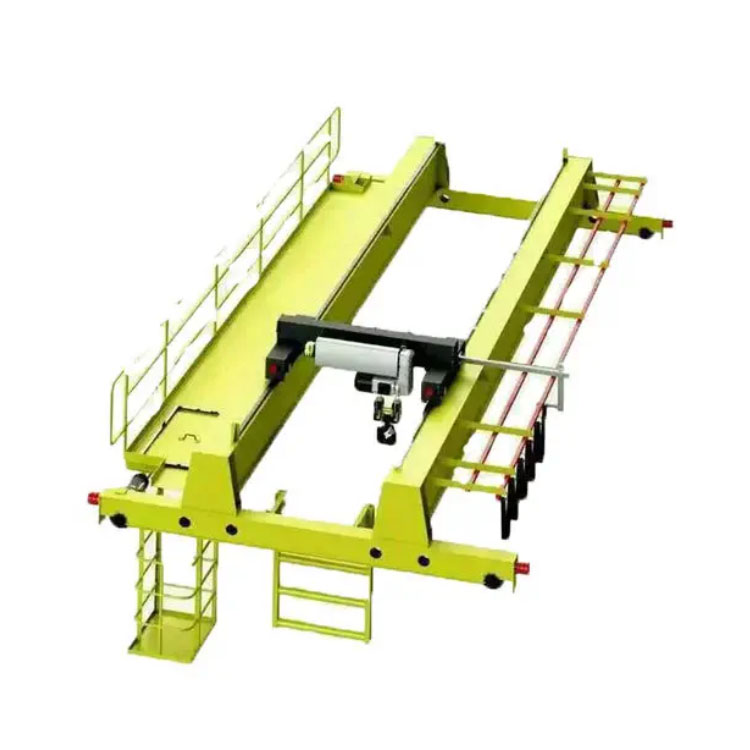Bridge Crane: An Essential Piece of Equipment in Heavy Lifting
2025-04-11
In industrial environments where heavy lifting is a daily necessity, the bridge crane plays a critical role in facilitating the movement of large and heavy materials. Whether it's in manufacturing plants, warehouses, construction sites, or shipyards, a bridge crane is essential for ensuring that materials are efficiently and safely handled. This blog explores the key features, benefits, and applications of bridge cranes, shedding light on why they are indispensable in various industries.
What is a Bridge Crane?
A bridge crane, also known as an overhead crane or a gantry crane, is a type of crane designed to lift and move heavy loads across a horizontal plane. It consists of a horizontal bridge that spans the width of a workspace and is supported by rails or runways. Attached to the bridge is a hoist that can move along the bridge’s length, lifting and lowering materials as needed.
Bridge cranes are typically powered by electric motors, but can also be operated manually or hydraulically, depending on the specific needs of the operation. They are versatile, efficient, and capable of handling very heavy loads, making them ideal for industrial environments.
Types of Bridge Cranes
1. Single Girder Bridge Crane:
A single girder bridge crane is equipped with one horizontal beam or girder that supports the hoist. This type of crane is typically used for lighter load lifting and is often found in smaller facilities or warehouses.
2. Double Girder Bridge Crane:
In a double girder bridge crane, two horizontal beams or girders support the hoist. This configuration allows for the lifting of much heavier loads and provides greater stability. Double girder cranes are commonly used in larger manufacturing plants and warehouses where heavy lifting is required.
3. Top Running Bridge Crane:
This type of crane operates on tracks or runways positioned above the workspace. The crane’s wheels run along the rails, allowing it to cover a large area. Top-running bridge cranes are often used in facilities with high ceilings and require maximum vertical clearance.
4. Underhung Bridge Crane:
Unlike the top-running crane, an underhung bridge crane operates on rails that are mounted beneath the building's support beams. This design is ideal for low-clearance environments, and these cranes are often used in smaller spaces or facilities with limited headroom.
Key Benefits of Bridge Cranes
1. Improved Efficiency:
One of the most significant advantages of using a bridge crane is the increase in productivity. The crane allows for the smooth and swift movement of heavy materials, reducing the need for manual handling and significantly speeding up operations. Workers can load and unload materials faster, which ultimately improves the overall efficiency of the facility.
2. Safety:
Bridge cranes improve safety by eliminating the need for workers to manually move heavy loads. This reduces the risk of accidents, injuries, and strain-related issues. Additionally, modern bridge cranes are equipped with safety features such as overload sensors, emergency stop buttons, and anti-collision systems to ensure that both workers and equipment remain safe during operation.
3. Heavy Load Capacity:
Bridge cranes are designed to handle a wide range of materials, including extremely heavy loads. This makes them essential for industries such as manufacturing, construction, and shipping, where materials can often weigh several tons. The lifting capacity of bridge cranes can range from a few tons to several hundred tons, depending on the crane’s configuration.
4. Space Optimization:
Since bridge cranes operate on overhead tracks, they do not take up valuable floor space. This makes them ideal for environments where floor space is limited, such as warehouses with narrow aisles or manufacturing facilities that need to make the most of their available area. The use of bridge cranes allows for a more efficient layout of machinery and materials within the facility.
5. Flexibility:
Bridge cranes are versatile and can be customized to suit specific lifting needs. They can be used in combination with other lifting equipment, such as hoists or trolleys, to lift a wide variety of materials, from small components to large structural elements. The crane can also be adapted with various lifting mechanisms to handle materials of different shapes and sizes.
Common Applications of Bridge Cranes
1. Manufacturing:
In manufacturing environments, bridge cranes are commonly used to lift and transport heavy components such as steel beams, motors, or machinery parts. The cranes facilitate the assembly process by moving materials quickly and safely between different workstations.
2. Warehouse and Distribution:
In warehouses, bridge cranes help in moving heavy goods, such as large pallets of materials or bulk storage containers. They streamline the loading and unloading process and make it easier to organize and transport goods in the warehouse.
3. Construction:
On construction sites, bridge cranes are used to lift and position heavy materials such as concrete blocks, steel beams, or prefabricated parts. These cranes are essential for building large structures, where precise and efficient lifting is required to ensure the safety and stability of the construction site.
4. Shipyards:
In shipbuilding and repair yards, bridge cranes are used to handle large and heavy items, such as ship parts, engines, or large components. These cranes can move materials across long distances within the yard and are critical to the construction and repair of ships.
5. Power Plants:
Bridge cranes are used in power plants to transport heavy equipment and components, including turbines, generators, and boilers. These plants often require cranes with high lifting capacities to handle the large and heavy machinery used in power generation.
Maintenance of Bridge Cranes
Like any piece of heavy equipment, bridge cranes require regular maintenance to ensure optimal performance and longevity. Routine inspections of components like the hoist, trolley, and tracks are necessary to identify wear and tear before they cause operational problems. Lubricating moving parts, checking safety mechanisms, and ensuring that all electrical components are in good condition are essential tasks for crane maintenance.
Regular training for crane operators is also important to ensure that they are aware of safety protocols and can efficiently operate the equipment. Proper training reduces the risk of accidents and maximizes the crane’s effectiveness.
Conclusion
The bridge crane is an indispensable tool in industries that require the movement of heavy materials. With its ability to handle massive loads with precision and efficiency, the bridge crane helps improve productivity, safety, and space utilization in various sectors. Whether used in manufacturing, construction, or shipping, bridge cranes remain a vital piece of equipment that enhances operations and supports the successful completion of large-scale projects.
By understanding the benefits and applications of bridge cranes, companies can make more informed decisions about how to integrate them into their facilities and improve their overall operations.



